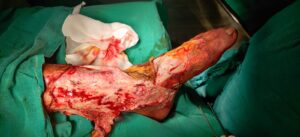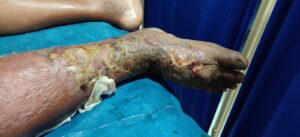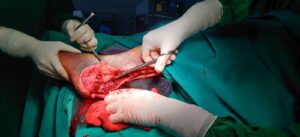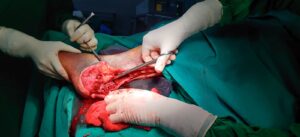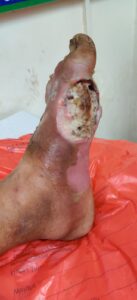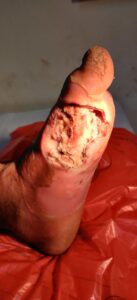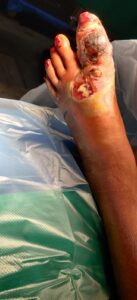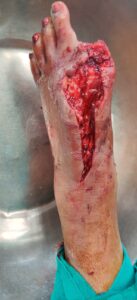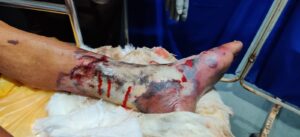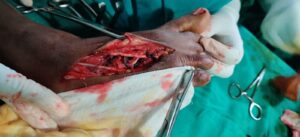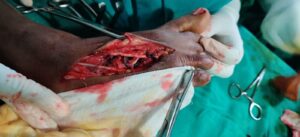A diabetic foot ulcer is an open sore or wound on the foot of a person with diabetes, most commonly located on the plantar surface, or bottom of the foot. Diabetic foot ulcers occur in approximately 15% of persons with diabetes. Of those who develop a foot ulcer, 6% will be hospitalized due to infection or other ulcer-related complication. The risk of foot ulceration and limb amputation increases with age and the duration of diabetes.
Diabetes is the leading cause of non-traumatic lower extremity amputations in the U.S. Between 14-24% percent of patients with diabetes who develop a foot ulcer will require an amputation, and foot ulceration precedes 85% of diabetes-related amputations. In the U.S., 82,000 amputations are performed each year on persons with diabetes, half of those age 65 or older.
The good news is that a foot ulcer is preventable if the underlying conditions causing it, diabetic peripheral neuropathy and/or peripheral arterial disease, are appropriately diagnosed and treated.
Causes
Peripheral neuropathy (nerve damage) and lower extremity ischemia (lack of blood flow) due to peripheral artery disease are the primary causes of diabetic foot ulcers.
Signs and Symptoms
Common signs and symptoms of a diabetic foot ulcer include:
- Appearance of drainage on the person’s socks
- Redness and swelling in the area
- Odor if the ulcer has progressed significantly
Treatment
A diabetic foot ulcer acts as a portal for systemic infections such as cellulitis, infected foot ulcers, and osteomyelitis. These are especially dangerous to patients with diabetes, whose impaired immunity increases their risk for local and systemic infection. Therefore, debridement and antibiotic therapy should be initiated as soon as possible. Blood sugar should also be monitored closely and controlled, because hyperglycemia may increase the virulence of infectious microorganisms.
The goal of treatment is to accelerate the healing process and decrease the chance for infection (or prevent a recurrence of infection). Treatment usually consists of:
- Optimal glucose control.
- Debridement – removal of all hyperkeratotic (thickened) skin, infected and nonviable, including necrotic (dead), tissue, slough, foreign debris, and residual material from dressings.
- Systemic antibiotics for deep infection, drainage, and cellulitis.
- Off-loading – Relieving the pressure from the ulcerated areas by having the patient wear special foot gear, a brace, specialized castings, or using a wheelchair or crutches.
- Creating a moist wound environment.
- Treatment with growth factors and/or cellular therapy if the wound is not healing.
